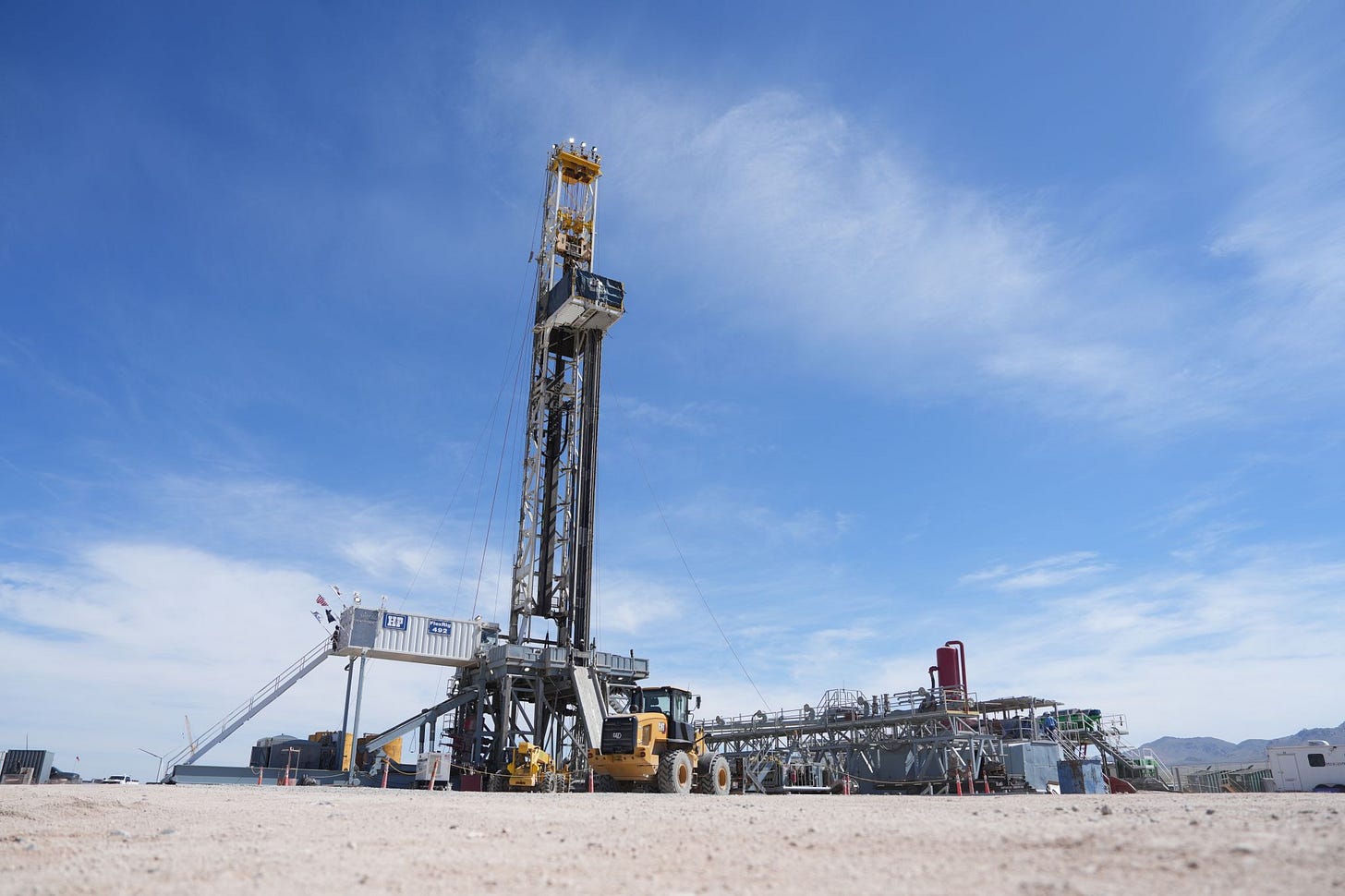🌋 Geothermal Becomes Asset Class; 🪨 Rare Earth Pilot in US; 🌱 Vertical Farming Goes Industrial; 🛠️ Rocket-Grade 3D Printing Scales; 🌕 Moon Mining Validated | Deep Tech Briefing #65
Weekly Intelligence on Deep Tech Startups and Venture Capital.
Thanks for reading Deep Tech Briefing, our weekly independent intelligence on Deep Tech Startups and Venture Capital. If you like what you see, I encourage you to subscribe to all our pieces here.
Dear Friends,
Geothermal now drills faster than the Department of Energy predicted. Recycling rare earths is no longer a policy white paper—it’s a plant in Ontario. And a hyperscaler just anchored baseload power from a startup that didn’t exist five years ago.
All of this, until recently, would have been seen as a weak signal, a proof of concept, a clue among many. Today, it stands as something more: the emergence of a real industrial architecture, one that transforms deep tech from a promise into a structure. It’s no longer just about advanced technologies seeking validation, but about assets beginning to speak the language of allocation, scale, and bankability.
This edition of the Briefing captures a precise moment. A threshold. Multiple players—across different sectors, in distinct geographies—are showing converging signals. Investment rounds are growing, but more interesting is their profile: a blend of equity and debt, the presence of infrastructure capital, disciplined multiples, and—more and more often—time horizons that go beyond the typical venture window. We’re witnessing a phase shift: from betting on technological breakthroughs to building operational models capable of supporting projects measured in hundreds of megawatts, tons of output, and decade-long contracts.
In this context, the very concept of risk evolves. It hasn’t disappeared—on the contrary, it has shifted. It’s no longer just about technical performance or scientific uncertainty, but settles on far more tangible ground: procurement, permitting, production capacity, delivery timelines. Where a roadmap once sufficed, now a full supply chain plan is required. Where the question used to be “does it work?”, it’s now “can it scale under operational pressure?”
On the institutional front, the environment is aligning with surprising speed. In recent weeks, we’ve seen a series of public initiatives—in Europe, the UK, and the U.S.—that aim to bridge the long-standing gap between frontier research and industrial capacity. It’s not just a matter of funding, but of systemic vision: industrial policy, strategic resilience, technological sovereignty. Still fragmented, but increasingly explicit, a new grammar of deep tech innovation is taking shape—one made of milestones, regulated access to public capital, and collaboration between patient capital and private actors.
Naturally, none of this means the challenges are behind us. Far from it. The constraints are simply shifting downstream. And for that reason, the reading of what’s happening must become sharper. This is no longer the time for easy enthusiasm—or default cynicism. It’s time for analysis.
This week’s Briefing is dense, layered, and moves across energy, automation, advanced manufacturing, space, security, and quantum. But more than the specific content, what matters is the direction these signals trace: a technological future that no longer lives in labs or in narrative, but in the operational decisions that are beginning to move capital, regulation, and responsibility.
Those working in this ecosystem today carry a dual responsibility: to read the contours of this shift with clarity, and to prepare themselves to engage without illusions. The risk is no longer that the technology won’t arrive. It’s that it will—and it will catch unprepared those who were waiting for it with the wrong frameworks.
Enjoy the read,
Giulia
✨ For more, see Membership | VC Guides | Insights | Deep Tech Catalyst
Interesting Reading
🔗 Let’s not repeat our solar energy mistake with quantum computing
The U.S. lost solar to China by underinvesting in industrial scale-up. Quantum could be next—unless policy and capital align.
Capital Brief🔗 The shifting geography of US deep tech
Deep tech is moving inland. Innovation hubs are no longer coastal, and capital needs to follow the migration.
New Geography🔗 World Bank agrees to end ban on funding nuclear energy
For the first time since 1959, the World Bank will fund nuclear—framing energy access as a human right and SMRs as core to climate equity.
World Nuclear News🔗 AI enabling cyberattacks at unprecedented scale, Gartner says
Generative AI is actively weaponizing the cybersecurity threat surface—compressing the attack timeline and multiplying vectors.
Cybersecurity Dive🔗 Fermentation rises as alternative proteins hold ground amid food tech VC slowdown
While consumer hype fades, infrastructure-led plays in fermentation are becoming the durable thesis in food tech.
Protein Production Technology🔗 Deep tech start-ups: a response to the challenges of the 21st century
A European view on deep tech as a systems-level response to intertwined scientific, climate, and industrial disruption.
Mines Paris–PSL🔗 Innovation surges in construction, but legal risks loom
As construction tech scales, litigation risk becomes the new bottleneck—where innovation meets regulation head-on.
Construction Dive🔗 Enhanced geothermal systems in the Great Basin could supply 10% of US electricity
Geothermal’s moment might finally be here—with new data pointing to a viable, dispatchable, continental-scale energy source.
USGS
In Today’s Briefing:
The Big Idea – Fervo Is Now the Strategic Thermometer of the EGS Sector: A Quick Reverse Diligence and Some Reflections
The Key Updates – Rare earth recycling scales in the West. A space startup vertically integrates propulsion. Cement hits a chemistry wall. A hyperscaler bets on next-gen baseload. Lunar mining clears lab validation. Ground robots enter gated markets. Retail trials autonomous food prep. A Euro hardware firm expands in the U.S and more.
Deep Tech Power Plays – Europe launches a pre-venture pipeline for deep tech. A G7 state injects $100B+ into semis, batteries, and moonshots. AV rollout gets legal greenlight. Fusion pilot access expands. Nuclear finance ban ends. Allied missile production becomes policy.
Before Go Ahead:
Deep Tech Briefing is just one part of The Scenarionist experience. To enjoy the full experience, become a Premium Member!
The Scenarionist Premium is designed to make you a better Deep Tech Founder, Investor, and Operator. Premium members gain exclusive access to unique insights, analysis, and VC Guides with the wisdom of the world’s leading Deep Tech thought leaders and more..
Join those who have an extra gear in Deep Tech.
💡The Big idea
Fervo Is Now the Strategic Thermometer of the EGS Sector: A Quick Reverse Diligence and Some Reflections
In recent years, we’ve witnessed a gradual industrialization of advanced geothermal energy, but with Fervo Energy, something seems to have truly shifted. Not just because of the announcement itself — a new well drilled to over 15,700 feet and reaching 520°F in just 16 days — but because of the simultaneous alignment of three factors: technical performance, financial credibility, and industrial visibility.
This is the moment when Enhanced Geothermal Systems (EGS) moves from “if it works” to “how fast can it scale.”
Let’s look at the numbers.




